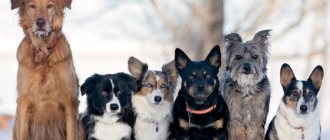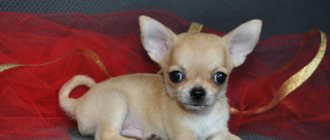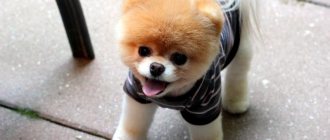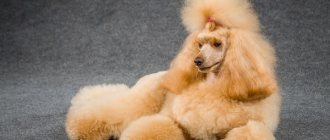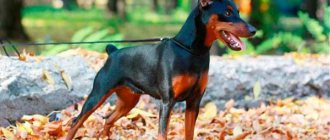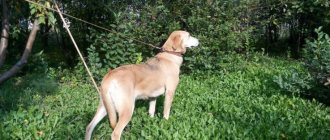The Labrador Retriever is a breed whose representatives always attract attention. They have an attractive and impressive appearance and a kind character. Let's take a closer look at who a Labrador Retriever is: description and characteristics of the breed, reviews from owners. These dogs have a harmonious combination of temperament and appearance. They are good companions and able to work.
Labradors are very useful for people. At the same time, it is difficult to call them guards and achieve aggressive behavior. The pet can notify of danger by loud barking. He is cheerful, which can be seen in his eyes. The dog is sure that the world is beautiful and no one will harm him.
Brief characteristics of the breed Amenable to training:
Gets along with animals:
Dirt in the apartment:
Puppy price:
Immunity and health:
Attachment to the owner:
History of the Labrador Retriever
The origin of the breed is still completely unknown. There is information that the first representatives came to England from Canada, the island of Newfoundland. The dogs first got their name from the island.
There are several theories about the appearance of the Labrador Retriever. One of them indicates origin from the Newfoundland breed. Breeder Dr. Woods believes that the breed originated on the island and involved Viking and Basque dogs. This kind of life affected the dogs’ habits. They feel equally at home on land and in water.
Fishermen from Newfoundland needed a helper - small in size so that he could get in and out of the boat himself. Water-repellent coat, high work capacity and a strong search instinct - these qualities are also important for fishermen.
During this period, two types of breeds developed - small and large representatives. Large dogs were used as draft force. But from the beginning of the 19th century they were sold to aristocrats in England because large dogs with long coats became fashionable. The name of the island stuck with them.
The small representatives were distinguished by waterproof and short hair, energy and agility. They felt great in the water and had a unique sense of smell. The dogs had names such as Lesser Newfoundland, Lesser St. John's and even Labrador. Large Newfoundlands are now very common, and from the small breeds Labradors evolved.
English athletes noticed the dogs' flexibility and swimming abilities. When pheasant hunting became fashionable, retrievers were used instead of setters and pointing dogs. At this time, the purity of the breed was not very important, so owners got puppies from parents with long and short coats.
Since 1830, small dogs began to be transported to England to develop a separate breed. Breeders began to follow a number of rules in order to preserve the natural characteristics of the dog. But they often experimented with breeding Labradors with other retrievers.
At the beginning of the century, Labradors appeared at exhibitions in England. At this time, retrievers were considered to be representatives with short and long coats, dark brown dogs and Norfolk dogs, which are no longer present. Later each species became a separate breed. Since 1903, Labrador Retrievers have been officially registered with the Kennel Club. For twenty years, large nurseries improved the breed and as a result modern representatives were formed.
Character
Labradors are balanced and easy to train dogs. They are known for their fantastic sense of smell and love for fetching. This allows them to work in customs services, perform the duties of guides and rescuers. Canadians have traditionally been used as draft and hunting dogs.
Labrador retrievers have millions of fans. They make excellent companions and nannies for children. These are friendly, gentle creatures. Canadians consider the owner to be the center of the universe and love to participate in family affairs. At the same time, these are sensitive, unobtrusive dogs that know when their company is unwelcome.
Labradors have a hard time with loneliness. If they are often left alone, they begin to spoil their owner's things and bark monotonously for a long time. There have been cases when dogs left home where they felt unwanted.
Labradors love children very much. They are not irritated by screams, noise, bustle and violent manifestations of love. Canadians love spending time with people, so their age doesn't matter. Labradors themselves remain children until they are 3 years old. Slow maturation is reflected in persistent enthusiasm and desire to play. This breed needs constant activity. If a dog is bored, it will entertain itself on its own, which can have a negative impact on the condition of the home.
Canadians are not prone to zoo aggression and get along easily with cats and dogs. Birds are an exception to the general picture. Labradors will not be able to suppress the instincts of the hunter, which means the bird will be in danger. The upbringing and socialization of Labradors begins at an early age. Canadians strive to earn the owner's approval and quickly remember commands.
Labrador is not suitable for home protection: it has no tendency to aggression. Dogs are friendly by nature and will be happy to meet anyone.
Breed characteristics
The Labrador is a carefree, cheerful and obedient dog. Differs in the following features:
- Balance and stable psyche.
- Versatility. The pet can act as a guide, companion, hunting dog, and even look after children.
- Strong build, the animal feels good in water.
- Webbing between the toes, due to which the Labrador does not get tired from swimming and moves quickly.
- A specific body structure that helps make long jumps.
- The tail is wide at the base, similar to the tail of an otter. In water it works like a rudder.
- When a pet wags its tail in the apartment, small things get lost.
- The coat helps to swim for a long time. It has many layers, a thin layer of fat.
- Thanks to the soft mouth, objects are not squeezed in the mouth.
- The dog is obedient, easily makes contact with the owner and trainer during training.
- Good health, but there are diseases of the joints, knees and hips. Sometimes there is an eye defect of a genetic nature.
Representatives of the breed are active, hardworking and love to play. Dogs are considered sprinters. On land they reach speeds of up to 20 km/h, in water – up to 5 km/h (more than ducks). The record jump is more than 8 m. Owners are often interested in the question, how long do Labradors live at home? Average life expectancy is 10-14 years. The first heat can begin at 8-12 months.
Breed standard
Representatives of the breed have developed muscles and a proportional physique. Their main characteristics:
- Wide head. In babies aged 3-4 months, it looks much larger than the body.
- The body is strong and long, wide chest, strong neck. Muscular and short lower back.
- Hanging ears are located slightly behind. The eyes are almond-shaped and widely set.
- The limbs are neat, round, webbed.
- The tail is similar to that of an otter. Thick at the base, tapering strongly at the end, oriented horizontally.
- The coat is hard, short and dense, the undercoat is well developed and has water-repellent qualities. Labradors inherited it from ancestors who lived in cold climates.
Wool generally has the following colors:
- black;
- pale yellow;
- brown (chocolate).
There are also additional acceptable colors:
- Golden.
- Cream.
- Fox ed.
There may be a small white spot on the chest. Let's look at the weight by month in the table.
| Age, months | Weight, kg |
| 1 | 3,4-3,8 |
| 2 | 7-8 |
| 3 | 12-14 |
| 4 | 17-19 |
| 5 | 21-22 |
| 6 | 24-26 |
| 7 | 26-28 |
| 8 | 28-30 |
| 9 | 29-32 |
| 10 | 30-36 |
| Further | 30-40 |
Character of dogs
Labradors are very smart, kind and energetic. They sense the owner's mood well. If the owner is not in a good mood or wants to relax alone, the pets will not pester. But it is important to direct a stormy temperament in the right direction, without punishment.
Dog owners especially emphasize the following character traits of the breed:
- kindness and positive attitude;
- loyalty and reliability;
- activity;
- intelligence;
- performance.
Labrador is considered a good companion. He is happy to serve the family and always be close to his owners. The pet vigorously shows joy by wagging its tail, which is why objects often fall off the shelves. At three years of age, dogs usually become calmer.
Animals love to be in the water, walk and run with the owner. They need constant attention. They do not show jealousy or aggression. People are attacked solely to play. Excellent students, they remember commands well. Training can take place at home.
The pet often barks, but not always for security purposes. Usually he's just happy to see everyone. Loves children, other dogs and even cats. Does not get along with birds, as the breed was bred to hunt pheasants. Instinct can awaken even in domestic dogs.
Before you think about keeping a Labrador in an apartment, you need to weigh the pros and cons. The pet sheds a lot, so cleaning can be difficult. It will take a lot of time for training, education and walking. But being in the fresh air is beneficial for the person himself. The animal's good qualities, such as loyalty, kindness and optimism, help to forget about shortcomings.
Maintenance, care
Growing Labrador puppies are a whirlwind, a hurricane and a typhoon rolled into one. They are extremely inquisitive, active and noisy, and are not yet fully accustomed to living in an apartment or house. They need to explore everything, try it out by heart, and a powerful tail wagging with lightning speed sweeps away everything in its path from tables, shelves and bedside tables. Therefore, in the first year and a half, until the puppy grows up and “settles down,” the apartment should be kept absolutely clean - household chemicals, books, shoes and other household items should be put in places where the young dog definitely cannot reach it.
In order for this pet to behave more quietly at home, it is advisable to take it for long walks during the day - having splashed out excess energy on the street, the growing Labrador will behave more quietly at home. But not for long. Given regular long walks after two years of age, such dogs will be less noisy and active at home. But before this age, you can forget about peace and quiet in the house.
Before buying a puppy, you should think about how to arrange the area in which it will live. It should be set up right away with the expectation that the dog will grow big and will not want to change its place. For the dog’s comfort, instead of the usual soft fabric, you should buy a special orthopedic mattress in a specialized pet store. Bowls or food stands should not slide. Before going to bed, it is better to walk your pet so that it does not disturb the sleep of others at night. Labradors are bathed as they become dirty.
The coat of these pets is short, so it requires less care, but there will still be a lot of falling hairs, especially if the dog is not walked for long. Many dog breeders have adapted to collecting dying hair with a vacuum cleaner pipe without an attachment, so first the puppy is accustomed to the noise of the vacuum cleaner, and then to similar collection of dying hairs. In this case, there will be less wool lying around the apartment.
There are many grooming tools for short-haired dogs, including:
- rubber scraper;
- furminator;
- wide stripping that perfectly combs out any undercoat.
Dogs up to one year old are usually combed only in order to accustom them to carrying out a similar procedure in the future, so you can use a regular massage brush.
Feeding
Dogs of this breed must spend most of the day in constant movement and are specially trained for long periods of work on rough terrain. Labradors also periodically have to swim in various bodies of water - natural or artificial - where the water is not always warm. Therefore, a layer of fat should accumulate under their skin, which will protect the dogs from hypothermia. In cold weather, these animals also spend energy to maintain heat.
So these tireless animals eat well, as if they were stocking up on food for several days. This animal is capable of eating and digesting any food, but you should remember that these dogs are prone to obesity, so you should never overfeed them!
The diet of these individuals should be:
- a well-balanced natural one recommended by a veterinarian;
- dry food, but only premium class.
To reward these pets for correctly executed commands, you can give a piece or two of chopped carrots, beets, or hard fruits. But encouragement should be in reasonable quantities, and not turn into a second lunch or dinner.
When this pet is fed dry food, one feeding can be done during a walk. When the dog has enough running, you can repeat the learned skills with it - this should be a calm training, without running or hurdles, since it will be followed by a full dinner. After such a long walk, combined with food, you can take the dog home - in this case, the pet will not disturb you at night.
Labradors do not have a stop signal for food, so he may constantly look at his owner and his family members with hungry eyes. However, this is not a reason to feed him from your plate, because the food that is put in his bowl is enough for him.
Upbringing
Dogs of this breed are easy to train and are much easier to train than representatives of other breeds. However, you should not put off training the purchased pet “for later”; it is important from the very beginning to accustom the puppy to the norms of behavior in the house and on walks.
Interesting! At three months, a Labrador puppy can perform tasks that are assigned to puppies of other breeds only at six months or later.
To train your pet, it is better to take it to classes with an instructor who conducts training according to a program specially designed for this breed.
This pet can be taught water rescue work, as this animal is a natural swimmer and loves to be in the water for a long time.
It should be remembered that in the first year or two you will need to pay maximum attention to the puppy in order to raise an obedient pet in the future. Although this pet is smart, the training process will require maximum patience from the owner.
Parenting mistakes
Owners should not delay raising these pets; if the training process is delayed even for a month or two, the puppy may develop bad habits that will take too long to correct.
This dog should not be allowed to beg for food from the common table - the Labrador must know that he will be fed only in a strictly designated place and at the appointed time.
You should not try to train this pet to be a watchman - this is not in his character, so the owner will only waste time trying to teach the Labrador to be watchdog qualities.
How to care at home?
Puppies and young pets are very active. They want to taste everything and get into everything. The tail lives on its own, knocking down objects around it. The Labrador's behavior is fun, but there is a risk of injury, poisoning, electric shock and intestinal obstruction. Therefore, you should keep your apartment perfectly clean. To prevent your pet from damaging the furniture, you need to distract him with games.
If you walk your dog often, by the time it is two years old, it will become calmer. But while growing up, you don’t need to count on a quiet life together. The breed does not have any exceptional features of keeping it in an apartment - its own place (it is better to choose an orthopedic mattress), a stand or non-slip dishes, evening exercise (so as not to disturb the owners’ sleep). Water treatments as necessary to prevent your pet from smelling like a dog.
Pets' fur is not very long, but it sheds a lot. Especially with insufficient walking in winter. If the baby gets used to the vacuum cleaner, the hairs can be collected with a brush or pipe. Many owners say that their puppies love this procedure.
The following tools will help in caring for the coat:
- Metal scraper with loop. If the undercoat is not too thick, it is used for the limbs and lower part of the body. You should not press intensely. Otherwise, the dog may be scratched and dermatitis and scratching will appear.
- Wide stripping. Used to prepare the dog for trimming. The thick undercoat is combed out well.
- Rubber scraper. Excellent collection of awns. A standard mitten with fingers will not bring results.
A furminator can cope with shedding, but using it before shows is dangerous, as it cuts off the spine. But if the breeder shows how to use it, it will fit the body.
Babies are brushed more so that they get used to it. Therefore, a massage brush with rounded teeth and a single-row brush will suffice. Add a gloss to the wool using a comb with boar bristles. If the shedding of an adult dog is not very strong, you can use the listed tools or purchase a slicker.
The coat should be combed dry and clean. Water procedures reduce the shedding time, and nutritional supplements lengthen it and harm the liver.
In hot weather, brown and black colors “rust”, so exhibition representatives should not be exposed to direct sunlight for a long time. A haircut will not help against the heat; the body will only heat up faster. It won’t save you from shedding either, since short hairs are more difficult to remove.
Nails are trimmed using special clippers. The cut is made below the living part of the claw. If your eyes are running, you should immediately contact a veterinarian.
According to reviews from owners, walking such a pet has the following features:
- Increased attention to passers-by, desire to play with them.
- Eating pieces of food on the asphalt, small gravel, leaves, which can cause diarrhea and vomiting.
- Frequent desire to run away. The pet does not hear the owner when he has found something interesting. Representatives of the breed often get lost, so it is necessary to attach a tag with a phone number and address to the collar.
- Excessive interest in all animals. If the dog you meet is friendly, the Labrador will want to tag along. You can run away from an aggressive dog and get lost.
Until your pet's training becomes perfect, you need to use a leash. Experienced owners recommend a standard fastening with three to five rings along the length.
Tape measures are not suitable for young pets. They get used to pulling without feeling jerks. There is no need for a noose or a strict collar unless we are talking about uncontrollable aggressors. Then they can be used temporarily. Harnesses should also not be chosen for walks.
Pets are not very clean and can get into deep puddles. In dirty weather, it is better to wear a raincoat. When training, you should use a blanket to avoid catching colds.
The cold is tolerated without problems. Labradors love snow more than heat. When walking for more than 15 minutes, you will need warm overalls. Especially when it comes to an elderly or unseasoned pet. Your pet can even live outside in winter if you provide it with cleanliness, warmth and sufficient attention. When keeping the animal outdoors, it is necessary to walk the animal and provide physical exercise.
Due to the fact that the fingers are pressed tightly against each other, debris accumulates between the pads. It gets stuck on thick fur. The dog, trying to get rid of it, wets its skin. As a result, there is a risk of infections and cracks. After walking, you will need to examine the limbs; in winter, you need to get rid of snowballs.
Before going out into the city, you should treat the pads with wax or Vaseline. This is necessary to protect the skin from reagents. When you get home, rinse with warm water.
Pros and cons of living in an apartment
Reviews from owners about Labradors are often positive.
These are unique, friendly dogs that bring a lot of joyful moments into a boring life. Keeping these dogs in an apartment is no different from keeping a dog in your own home: the dog will still sleep either with you or near your bed. Enclosures , and especially sitting on a chain, for animals
The advantages of the breed include the following:
- easy care;
- obedience and restraint;
- kind and lively character;
- beautiful appearance.
The disadvantages of Labradors are mainly determined not by the breed of the dog, but by its upbringing. The disadvantages of keeping dogs in an apartment include the following:
- The energy and activity of young dogs, which force them to take long and varied walks in any weather.
- Possible damage to property. The puppy needs space for activity, and if it is not provided properly, then all the personal belongings of the owners will be used.
- Expensive food.
But all these disadvantages pale in comparison to how much goodness and happiness Labrador brings to every home. Adult dogs turn into stately, beautiful dogs that evoke the admiration of others and the pride of their owners.
Reviews from Labrador owners
I also have a Labrador dog. This is not only a beautiful, but also the smartest and most loyal dog. The author of the article clearly noted that the Labrador is first and foremost a friend and companion. And keeping it in an apartment is really very simple, even in a one-room apartment. Labradors are completely unpretentious and at the same time very attached to their owner.
Alla Mogileva. Moscow
An adult Labrador is hard. Constant wool, dirt from walks, damaged things and furniture. In any weather, I walk for 1.5-2 hours. But I was ready for difficulties; any animal in the house means responsibility, giving up your habits.
This kind, smart look with which Nick looks at me is dearer than anything in the world. And for this reason you get up every day at 5 am to run and walk with the dog.
Andrew Vladimirovich. Saratov
We have been the owners of Labrador for a year now. There was so much torment with the little puppy, as if a small child had appeared in the house again. But now he has grown up, and it has become much easier. The whole family walks, runs, and plays.
Of course, there is not enough space in the apartment, but we knew that the dog would be large.
And even regular cleaning is no longer frustrating. The main thing is that the dog is very kind and gets along well with children. Valentina Petrova. Saint Petersburg
Education and training
The pet is easy to train and train. It is necessary to start in a timely manner, otherwise the mature dog will develop unwanted habits. At three months, Labradors can already solve problems that others can only cope with at six to seven months. For training, you can contact specialists who use specially developed programs.
Your pet should not be left without activities. It is necessary that he brings slippers to the owner and catches toys. Dogs love to swim and dive. If you teach your pet the “Fetch” command and play with it, he will appreciate it.
Owners need to pay attention to their pet so that it gets used to communicating with people. It is important to patiently explain what not to do. It is necessary to educate without physical punishment and screaming.
You can read more about training and raising a Labrador in this article on our website.
Appearance
Head and neck:
- The wide skull and lack of fleshy cheeks make the head powerful;
- The transition from forehead to muzzle is well defined;
- Correct bite, teeth are of medium size;
- Hazel eyes;
- The ears are mobile, set behind the head, usually take a hanging position, easily change it due to the absence of strong gravity;
- The neck is strong and strong.
Body and tail:
- Smooth back line;
- Wide chest with compressed ribs;
- The tail should not curl over the back; resembles an otter's tail; has a thick coat of fur.
Limbs:
- Straight line of the forelimbs, development of the hind limbs;
- The feet are round and compact, with webbed toes and pronounced pads.
Wool:
- Thick short six;
- The undercoat is waterproof.
What to feed a Labrador at home?
Dogs are not very picky eaters. They eat everything they find on the way or is on their plate. It is necessary to take a responsible approach to choosing a diet so that your Labrador does not become overweight and his health does not deteriorate.
You can give natural or prepared food. The latter are balanced and do not require cooking time. It is better to purchase food not lower than the premium segment in order to reduce visits to veterinarians.
Food is selected according to age criteria. If a dog is obese, it is put on a diet menu. There are options for nursing, weakened animals. Feeding occurs strictly according to the instructions on the package.
The following natural products are suitable for your dog:
- Boiled and raw meat, offal.
- Fish without bones, mostly from the sea.
- Cereals. Anything will do except barley and oatmeal. Porridge can be replaced with black bread crackers.
- Fermented milk products (cottage cheese, cheese), raw yolks with cereals and vegetables.
- Chopped zucchini, pumpkin, carrots, beets, cabbage with sour cream or butter.
In this case, vitamin complexes will be required. They are especially relevant in winter.
What food is best to feed a puppy?
First, the baby needs to be given the usual food. You should clarify this issue with the breeder. After a week, it is allowed to gradually introduce a new diet.
It is necessary to immediately teach the dog to eat in one place and at one time. A plate with pieces of uneaten food should be removed immediately. Water should always be available in the public domain. For small pets, the following nutritional plan is relevant:
- Up to 2 months – 6 times a day.
- Up to 4 months – 5 times.
- Up to six months – 4 times.
- 7 months - year - 3 times.
- Next - 2 times.
Estrus, mating and birth
The first heat in Labradors can begin after the change of teeth or between the ages of 1 and 2 years. Usually there are 1-2 heats per year. The first mating takes place after the female turns 20 months old, and the male turns 18. The best time for mating is 10-15 days of estrus.
Mating is carried out on the territory of the male dog. A few days before mating, he is fed high-protein food or the amount of meat is increased. It is not recommended to feed the groom before mating.
If the owner is inexperienced in mating, he should invite an instructor.
Pregnancy in Labradors lasts about 64 days. If the female carries many puppies, labor may begin earlier (on the 57th day); if there are few, then later (on the 66th). Contractions last from 10 hours to a day. It is not recommended to give birth on your own: there is a high risk of unforeseen situations. The owners may not have the necessary medications and equipment.
Advantages and disadvantages of the breed
Pros of Labradors:
- good physical form;
- excellent health, endurance;
- adaptability to any climatic conditions;
- minimal care;
- ease of training, high ability to learn commands, agility;
- unique memory;
- innate fetching skills;
- devotion, lack of desire for dominance;
- adaptability to any rhythm of life of the owners.
Minuses:
- Excessive friendliness, lack of security abilities.
- High need for activity and training.
- Possibility of property damage due to boredom.
- Hyperactivity, which changes with proper upbringing.
- Slow growing up. Childhood lasts up to three years, which is why the dog sometimes does not obey.
- High love for water, the pet will dive into puddles.
- Lack of moderation in food. The dog eats everything that comes in its way.
- Desire to play with stray dogs and other animals.
- Uncontrollability in the absence of education. This is noticeable when walking, when the dog drags the owner in the right direction.
Bad habits can be eliminated with proper training. Then the negative qualities of the Labrador will not appear.
Results
But at the end of all reviews about Labradors, the owners note that despite all the shortcomings of the breed, it is their fault, since some point was missed in raising the puppy. In cases where the dog was not the first in the family and the owners took their upbringing and training with greater responsibility, it is noted that this is not just a dog, but a real family member who will not be exchanged for anyone else.
Owners of Labradors in the apartment speak of the breed as requiring a lot of toys and personal items. By constantly buying your dog something interesting and chewable, you save your belongings and interior, and the dog plays enthusiastically while he waits for you from work.
In any case, you should remember that all the strength that you put into a Labrador puppy will return to you threefold in the form of a kind, cheerful and cheerful dog that will leave an indelible mark on your heart after its last breath.
Diseases and pathologies to which dogs are susceptible
Labradors may suffer from the following diseases:
- Dysplasia of the hip or elbow joint. In this case, the hind or front legs fail.
- Excess weight.
- Panosteitis. A pathology that develops due to rapid growth. Young dogs often get sick.
- Osteochondrosis. The hock, knee and shoulder joints are usually affected.
- Cataracts, progressive retinal atrophy.
- Licking granuloma. Idiopathic licking causes ulcers on the paws. Usually observed in representatives of the fawn colored breed.
- Epilepsy. Rarely appears.
- Dandruff.
Labradors often have bald patches on their elbows. They appear due to an incorrect diet and hard floors in the apartment.
Three colors of Labrador
According to the standard, Labradors come in three colors:
- Black;
- Chocolate;
- Fawn.
Black coloring is considered traditional and is complemented by brown or hazel eyes and dark earlobes. A dog with such fur shines and shimmers in the sun. The blackness can be diluted with a white spot on the chest or tan marks.
Chocolate Labradors became popular thanks to the American President, who was publicly presented with a puppy with this color.
The “boom” of dogs with brown fur has not yet passed, and more and more people want to have such a spectacular pet.
The combination of chocolate color with hazel or yellow eyes is also interesting. However, “rich” chocolate must be properly cared for: do not keep dogs in the sun for long and feed it with special vitamins.
Labradors with fawn coats come with golden, light cream, red tint or brown pigmentation.
The cost of a puppy and how to choose one?
The price of a Labrador retriever is influenced by the following criteria:
- pedigree;
- quality of cultivation;
- appearance.
These add up to the cost - from 20 to 60 thousand rubles.
When purchasing, you should pay attention to the following nuances:
- Lack of aggressiveness and timidity.
- Friendliness.
- Thick build without excess weight.
- A good appetite.
- No fleas or damage to the skin.
Puppies
The Labrador, along with decorative dogs, is the most popular pet companion. Therefore, there are many offers on the Internet for the sale of puppies of this breed. However, if the future owner wants to purchase a guaranteed healthy pet, then it is better to turn to reputable breeders. A self-respecting representative of the kennel values his reputation and will never bring together for mating females and males with an unstable psyche or poor health.
Choosing a puppy
When choosing a puppy from a nursery, you should pay attention to how the lactating female behaves. She should be calm, even if strangers come up to take a closer look at the litter. A healthy puppy will be moderately active, good-natured, will always allow itself to be petted and will invite a stranger to play.
Breeders can issue a document confirming tests for dysplasia and eye diseases in addition to the usual pedigree and diplomas of parents at famous exhibitions.
Price
The cost of a puppy is determined by the following factors:
- the pedigree of his parents;
- the conditions in which he was kept, diet, vaccinations performed;
- exterior.
Based on these conditions, the cost of a small Labrador can range from 20,000 to 60,000 rubles.
What to name a Labrador?
It is easy to choose a nickname for representatives of this breed. The dog is big, but very kind. Therefore, both cute names (Baby) and representative names (Count) are suitable for her.
boy
Many owners name their animals after their favorite singers, actors, literary and mythological characters. Fans of The Three Musketeers can name the boy Athos, Porthos or Aramis. The name Locky is suitable for cunning pets. Often English nicknames are chosen for Labradors, such as Mike, Harry, Charlie, Bobby, Alex, Chris.
girl
Female Labradors are charming, loyal and devoted. The name Diana is suitable for the pet, in honor of the Roman goddess of the hunt. Aurora, Assol, Elsa, Stella are gentle nicknames that personify the character of dogs. Names named after flowers will sound harmonious - Jasmine, Rose, Astra.
Video: Labrador Retriever: description and characteristics of the breed
Health and life expectancy
With proper care, Labradors live 10-14 years.
Health problems and prevention:
- Many diseases in Labradors are hereditary. You should ask breeders about the health status of the puppy's parents.
- Dysplasia is a defect in the hip joint. To avoid this defect, you need to closely monitor the puppy. Until the age of 6 months, he should not be exposed to physical exertion and should not move up the stairs independently.
- Diabetes and obesity. Everything here is actually simple - proper nutrition and balanced exercise. To check whether you have overfed your Labrador or not, feel the ribs. They should not be visible, but should be felt.
- Allergy. The main cause of attacks is food, chicken being the most allergic. For prevention purposes, you can use a 1-3 week course of enterosgel. You need to make sure that the Labrador eats, and do not allow your friends to treat him with anything. Self-medication is not suitable in this situation. You need to go to the vet immediately.
It is necessary to be vaccinated against canine distemper, infectious hepatitis, rabies, parvovirus enteritis, parainfluenza, leptospirosis.
Photo and video review
Video materials allow you to evaluate the behavioral skills of Labradors. The variety of colors is shown in the photographs. It is important to read the information provided so as not to make mistakes when choosing a pet.
Labradors are positioned as surprisingly sociable dogs with a balanced character. They are able to make friends, be loyal, and are easy to learn. Considering that the color of the coat does not affect the developing qualities of the pet, they select it in accordance with their own expectations and preferences.
Unusual colors
In addition to those described above, there are species with unusual colors. These include Dudley, spotted and silver Labradors. The main difference between Dudley and the standard is the pinkish tip of the nose and light pigmentation of the gums and eyelids. Golden dudleys are most common, but they also come in black and cream. The eyes of these animals may even be green, which is unacceptable for the standard.
Spotted dogs are also considered an unacceptable deviation from the standard, although they look quite cute. But the silver Labrador, which is not included in the breed standard, is quite popular at the moment. Although it will not be possible to participate in exhibitions with him, many people want to buy a dog of this particular color. And demand, as you know, creates supply, so silver dogs can be purchased at a very high price. Although you will not be able to participate in dog shows with a pet of non-standard colors, this does not mean that such a dog will not become a loyal friend and family member. In addition, by purchasing an animal of an unusual color, you will spend much less money.
Similar article: Weight of a puppy and an adult Labrador by month
How to train a dog
When training a dog, the key is to be patient. No need to be aggressive. Labradors are very smart dogs and quickly grasp everything on the fly, but it takes time for them to start following certain commands. It is best to alternate activities so that your Labrador does not get bored with the activity and become distracted by something else.
It is very important to socialize a Labrador so that the dog does not show anxiety around other people or animals, behaves with dignity during walks, and does not experience stress.
